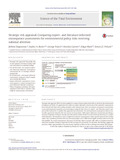JavaScript is disabled for your browser. Some features of this site may not work without it.
| dc.contributor.author | Dagonneau, J. | |
| dc.contributor.author | Rocks, Sophie A. | |
| dc.contributor.author | Prpich, George | |
| dc.contributor.author | Garnett, Kenisha | |
| dc.contributor.author | Black, Edgar | |
| dc.contributor.author | Pollard, Simon J. T. | |
| dc.date.accessioned | 2017-05-04T14:26:47Z | |
| dc.date.available | 2017-05-04T14:26:47Z | |
| dc.date.issued | 2017-04-07 | |
| dc.identifier.citation | Dagonneau J, Rocks SA, Prpich G, Garnett K, Black E, Pollard SJT, Strategic risk appraisal. Comparing expert- and literature-informed consequence assessments for environmental policy risks receiving national attention, Science of the Total Environment, Volume 595, 2017, Pages 537 - 546. | en_UK |
| dc.identifier.issn | 0048-9697 | |
| dc.identifier.uri | http://dx.doi.org/10.1016/j.scitotenv.2017.03.293 | |
| dc.identifier.uri | http://dspace.lib.cranfield.ac.uk/handle/1826/11858 | |
| dc.description.abstract | Strategic risk appraisal (SRA) has been applied to compare diverse policy level risks to and from the environment in England and Wales. Its application has relied on expert-informed assessments of the potential consequences from residual risks that attract policy attention at the national scale. Here we compare consequence assessments, across environmental, economic and social impact categories that draw on ‘expert’- and ‘literature-based’ analyses of the evidence for 12 public risks appraised by Government. For environmental consequences there is reasonable agreement between the two sources of assessment, with expert-informed assessments providing a narrower dispersion of impact severity and with median values similar in scale to those produced by an analysis of the literature. The situation is more complex for economic consequences, with a greater spread in the median values, less consistency between the two assessment types and a shift toward higher severity values across the risk portfolio. For social consequences, the spread of severity values is greater still, with no consistent trend between the severities of impact expressed by the two types of assessment. For the latter, the findings suggest the need for a fuller representation of socioeconomic expertise in SRA and the workshops that inform SRA output. | en_UK |
| dc.language.iso | en | en_UK |
| dc.publisher | Elsevier | en_UK |
| dc.rights | Attribution 4.0 International (CC BY 4.0) You are free to: Share — copy and redistribute the material in any medium or format, Adapt — remix, transform, and build upon the material for any purpose, even commercially. The licensor cannot revoke these freedoms as long as you follow the license terms. Under the following terms: Attribution — You must give appropriate credit, provide a link to the license, and indicate if changes were made. You may do so in any reasonable manner, but not in any way that suggests the licensor endorses you or your use. Information: No additional restrictions — You may not apply legal terms or technological measures that legally restrict others from doing anything the license permits. | |
| dc.subject | Risk | en_UK |
| dc.subject | Strategic | en_UK |
| dc.subject | Environment | en_UK |
| dc.subject | Policy | en_UK |
| dc.subject | Expert | en_UK |
| dc.subject | Appraisal | en_UK |
| dc.title | Strategic risk appraisal. Comparing expert- and literature-informed consequence assessments for environmental policy risks receiving national attention | en_UK |
| dc.type | Article | en_UK |
Files in this item
This item appears in the following Collection(s)
-
Staff publications (SWEE) [2825]
